Tösstal railway line
The Tösstal railway line (Töss Valley Railway, German: Tösstalbahn or TTB) is a railway in the Swiss canton of Zürich, which serves the communities of the Töss Valley. Passenger service on the line now forms part of the Zürich S-Bahn, branded as the S26, and the standard Zürcher Verkehrsverbund (ZVV) zonal fare tariffs apply to the line. It is one of the network's less-heavily traveled lines, and most of the route is single-tracked.[2][3]
| Tösstal railway line (S26) | |||||||||||||||||||||||||||||||||||||||||||||||||||||||||||||||||||||||||||||||||||||||||||||||||||||||||||||||||||||||||||||||||||||||||||||||||||||||||||||||||||||||||||||||||||||||||||||||||||||||||||||||||
|---|---|---|---|---|---|---|---|---|---|---|---|---|---|---|---|---|---|---|---|---|---|---|---|---|---|---|---|---|---|---|---|---|---|---|---|---|---|---|---|---|---|---|---|---|---|---|---|---|---|---|---|---|---|---|---|---|---|---|---|---|---|---|---|---|---|---|---|---|---|---|---|---|---|---|---|---|---|---|---|---|---|---|---|---|---|---|---|---|---|---|---|---|---|---|---|---|---|---|---|---|---|---|---|---|---|---|---|---|---|---|---|---|---|---|---|---|---|---|---|---|---|---|---|---|---|---|---|---|---|---|---|---|---|---|---|---|---|---|---|---|---|---|---|---|---|---|---|---|---|---|---|---|---|---|---|---|---|---|---|---|---|---|---|---|---|---|---|---|---|---|---|---|---|---|---|---|---|---|---|---|---|---|---|---|---|---|---|---|---|---|---|---|---|---|---|---|---|---|---|---|---|---|---|---|---|---|---|---|---|
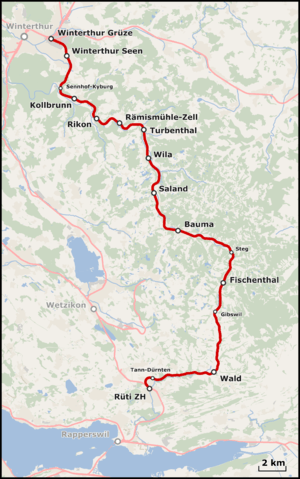 | |||||||||||||||||||||||||||||||||||||||||||||||||||||||||||||||||||||||||||||||||||||||||||||||||||||||||||||||||||||||||||||||||||||||||||||||||||||||||||||||||||||||||||||||||||||||||||||||||||||||||||||||||
| Overview | |||||||||||||||||||||||||||||||||||||||||||||||||||||||||||||||||||||||||||||||||||||||||||||||||||||||||||||||||||||||||||||||||||||||||||||||||||||||||||||||||||||||||||||||||||||||||||||||||||||||||||||||||
| Type | Heavy rail | ||||||||||||||||||||||||||||||||||||||||||||||||||||||||||||||||||||||||||||||||||||||||||||||||||||||||||||||||||||||||||||||||||||||||||||||||||||||||||||||||||||||||||||||||||||||||||||||||||||||||||||||||
| System | Zürich S-Bahn | ||||||||||||||||||||||||||||||||||||||||||||||||||||||||||||||||||||||||||||||||||||||||||||||||||||||||||||||||||||||||||||||||||||||||||||||||||||||||||||||||||||||||||||||||||||||||||||||||||||||||||||||||
| Status | Operational | ||||||||||||||||||||||||||||||||||||||||||||||||||||||||||||||||||||||||||||||||||||||||||||||||||||||||||||||||||||||||||||||||||||||||||||||||||||||||||||||||||||||||||||||||||||||||||||||||||||||||||||||||
| Locale | Zürich, Switzerland | ||||||||||||||||||||||||||||||||||||||||||||||||||||||||||||||||||||||||||||||||||||||||||||||||||||||||||||||||||||||||||||||||||||||||||||||||||||||||||||||||||||||||||||||||||||||||||||||||||||||||||||||||
| Termini | Winterthur Grüze Rüti ZH | ||||||||||||||||||||||||||||||||||||||||||||||||||||||||||||||||||||||||||||||||||||||||||||||||||||||||||||||||||||||||||||||||||||||||||||||||||||||||||||||||||||||||||||||||||||||||||||||||||||||||||||||||
| Stations | 17 | ||||||||||||||||||||||||||||||||||||||||||||||||||||||||||||||||||||||||||||||||||||||||||||||||||||||||||||||||||||||||||||||||||||||||||||||||||||||||||||||||||||||||||||||||||||||||||||||||||||||||||||||||
| Website | ZVV (in English) | ||||||||||||||||||||||||||||||||||||||||||||||||||||||||||||||||||||||||||||||||||||||||||||||||||||||||||||||||||||||||||||||||||||||||||||||||||||||||||||||||||||||||||||||||||||||||||||||||||||||||||||||||
| Operation | |||||||||||||||||||||||||||||||||||||||||||||||||||||||||||||||||||||||||||||||||||||||||||||||||||||||||||||||||||||||||||||||||||||||||||||||||||||||||||||||||||||||||||||||||||||||||||||||||||||||||||||||||
| Owner | Swiss Federal Railways | ||||||||||||||||||||||||||||||||||||||||||||||||||||||||||||||||||||||||||||||||||||||||||||||||||||||||||||||||||||||||||||||||||||||||||||||||||||||||||||||||||||||||||||||||||||||||||||||||||||||||||||||||
| Operator(s) | THURBO | ||||||||||||||||||||||||||||||||||||||||||||||||||||||||||||||||||||||||||||||||||||||||||||||||||||||||||||||||||||||||||||||||||||||||||||||||||||||||||||||||||||||||||||||||||||||||||||||||||||||||||||||||
| Rolling stock | Stadler GTW (most trains) | ||||||||||||||||||||||||||||||||||||||||||||||||||||||||||||||||||||||||||||||||||||||||||||||||||||||||||||||||||||||||||||||||||||||||||||||||||||||||||||||||||||||||||||||||||||||||||||||||||||||||||||||||
| Technical | |||||||||||||||||||||||||||||||||||||||||||||||||||||||||||||||||||||||||||||||||||||||||||||||||||||||||||||||||||||||||||||||||||||||||||||||||||||||||||||||||||||||||||||||||||||||||||||||||||||||||||||||||
| Track gauge | 1,435 mm (4 ft 8 1⁄2 in) | ||||||||||||||||||||||||||||||||||||||||||||||||||||||||||||||||||||||||||||||||||||||||||||||||||||||||||||||||||||||||||||||||||||||||||||||||||||||||||||||||||||||||||||||||||||||||||||||||||||||||||||||||
| |||||||||||||||||||||||||||||||||||||||||||||||||||||||||||||||||||||||||||||||||||||||||||||||||||||||||||||||||||||||||||||||||||||||||||||||||||||||||||||||||||||||||||||||||||||||||||||||||||||||||||||||||
History
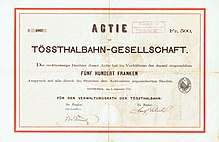
The Tösstalbahn (TTB) opened between Winterthur Grüze and Bauma was on 4 May 1875, and its continuation to Wald opened on 15 October 1876. At Wald the line connected with the independently owned Wald-Rüti-Bahn (WR) from Rüti ZH, which had itself opened on 29 September 1876. The two lines remained in separate ownership until they both became part of the Swiss Federal Railways (SBB) on 10 June 1918, although the TTB had operated the WB from 1902.
In 1901, the Uerikon-Bauma-Bahn (UeBB) opened, providing a third access point to the Tösstal line at Bauma. This line was never a great success, and in 1948 much of it was abandoned, but the stretch from Hinwil to Bauma was acquired by the SBB, retained and electrified. However passenger services ceased by 1979, and the Hinwil to Bauma section is now operated as a preserved railway by the Dampfbahn-Verein Zürcher Oberland (DVZO).[4][5]
In 1990, the passenger service on the Tösstalbahn became part of the Zürich S-Bahn network. Operation remained the responsibility of the SBB, with service provided using RBDe 560, with occasional RBe 540 supplements. Einheitswagen ("standard coaches") I or II as well as a BDt or Bt control car made up the rest of the consist, all of which were generally in the NPZ (blue over white) livery.
In December 2006, THURBO, a regional railway partly owned by the SBB, took over the operation of the S26 passenger service and provided new rolling stock. The line remains in the ownership of the SBB.[6]
Since December 2018, the S 11 Aarau - Lenzburg - Dietikon - Zurich HB - Stettbach - Winterthur - Seuzach/Sennhof-Kyburg (- Wila) has been operating on a section of the Tösstalbahn. During rush hours, the upgrades that have taken effect enable the S-Bahn to run an hourly service to Wila, but without stopping in Rämismühle-Zell. In 2019, the continuous half-hourly interval of the S26 between Winterthur and Rüti ZH has been introduced.
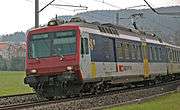 Typical S26 equipment in 2006 - the SBB-CFF-FFS RBDe 560
Typical S26 equipment in 2006 - the SBB-CFF-FFS RBDe 560
Operation
Route
The line runs from a northern terminus in Winterthur Hauptbahnhof, the main station of the city of Winterthur, to a southern terminus at Rüti ZH station, on the railway line from Zürich to Rapperswil via Uster. In so doing it passes through the Zürcher Oberland following the valleys of the Töss river and Jona river.[2][3]
Along its route, the line serves the following stations:[2][3]
- Winterthur Hauptbahnhof
- Winterthur Grüze
- Winterthur Seen
- Sennhof-Kyburg
- Kollbrunn
- Rikon
- Rämismühle-Zell
- Turbenthal
- Wila
- Saland
- Bauma
- Steg
- Fischenthal
- Gibswil
- Wald
- Tann-Dürnten
- Rüti ZH
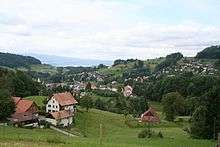 Tösstal near Wald.
Tösstal near Wald.- Stadler GTW train at Rikon.
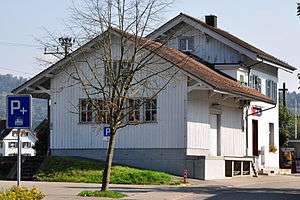 Wila railway station.
Wila railway station.
Services
The S26 provides the only regular passenger service over the bulk of the Tösstalbahn. It provides an hourly service between Winterthur and Rüti, with additional trains giving two trains per hour on the section between Winterthur and Bauma. A journey along the full route takes 64 minutes.[3][7]
The stations in the Winterthur suburbs are also served by other S-Bahn services, with the S12 serving Winterthur Seen and Winterthur Grüze stations, and the S35 serving Winterthur Grüze only.[3]
Rolling stock
Passenger service is in the hands of Stadler GTW units provided by THURBO.
References
- Eisenbahnatlas Schweiz (Swiss railway atlas). Schweers + Wall. 2012. p. 13. ISBN 978-3-89494-130-7.
- Eisenbahnatlas Schweiz. Verlag Schweers + Wall GmbH. 2012. pp. 12–13. ISBN 978-3-89494-130-7.
- "S-Bahn trains, buses and boats" (PDF). ZVV. Archived from the original (PDF) on 2013-04-01. Retrieved 2013-09-30.
- "Uerikon-Bauma-Bahn". www.eingestellte-bahnen.ch (in German). Retrieved 2013-04-03.
- "SBB Betrieb ab 1947" [SBB operating from 1947] (in German). DVZO. Retrieved 2013-04-03.
- "Meilensteine" [Milestones] (in German). Retrieved 2013-09-30.
- "Winterthur–Bauma–RütiZH" (PDF). Bundesamt für Verkehr. Retrieved 2013-03-21.